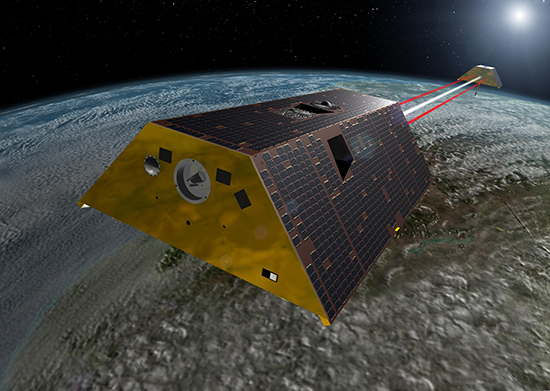
GRACE-FO
Jump to: Mission Objectives, Mission Instrumentation, Mission Parameters, Additional Information
Mission Photos:

Image credit: NASA
Mission Objectives:
GRACE-FO is a successor to the GRACE mission to continue its primary goal to monitor the static and time-variable components of the Earth's gravity field. Secondly, GRACE-FO will carry a Laser Ranging Interferometer as a technology demonstrator for high accuracy inter-satellite range measurements. Also the GRACE radio occulation measurements will be continued.
GRACE-FO Mission Parameters:
| Satellite | GRACE-FO-1 | GRACE-FO-2 |
| Sponsor: | NASA JPL and the German Research Centre for Geosciences (GFZ). | NASA JPL and the German Research Centre for Geosciences (GFZ). |
| Expected Life: | 5 years | 5 years |
| Primary Applications: | Monitor the static and time variable components of the Earth's gravity field. | Monitor the static and time variable components of the Earth's gravity field. |
| Primary SLR Application: | Precision orbit determination | Precision orbit determination |
| Launch Date: | May 22, 2018 | May 22, 2018 |
| COSPAR ID: | 1804701 | 1804702 |
| SIC: | 0123 | 0124 |
| NORAD: | 43476 | 43477 |
| NP Bin Size: | 5 seconds | 5 seconds |
| RRA Diameter: | ||
| RRA Shape: | Hemispherical/Pyramid | Hemispherical/Pyramid |
| Reflectors: | 4 corner cubes | 4 corner cubes |
| Orbit: | circular | circular |
| Inclination: | 89 degrees | 89 degrees |
| Eccentricity: | 0 degrees | 0 degrees |
| Perigee: | 500 km | 500 km |
| Period: | 90 min | 90 min |
Additional Information:
Web sites:
- NASA JPL's GRACE-FO website
- GFZ - Potsdam's GRACE-FO web page
- ILRS GRACE-A, -B mission pages
- NASA JPL's GRACE website
- GFZ - Potsdam's GRACE web page
Publications:
- Bertiger W., Bar-Sever Y., Dorsey A., et al. (2020). "GipsyX/RTGx, a new tool set for space geodetic operations and research", Adv. Space Res., 66(3), 469-489, DOI: 10.1016/j.asr.2020.04.015
- Boisits J., Landskron D., Boehm J. (2020). "VMF3o: the Vienna Mapping Functions for optical frequencies", J. Geodesy, 94(6), 57, DOI: 10.1007/s00190-020-01385-5
- Innerkofler J., Kirchengast G., Schwarz M., Pock C., Jaeggi A., Andres Y., Marquardt C. (2020). "Precise Orbit Determination for Climate Applications of GNSS Radio Occultation including Uncertainty Estimation", Remote Sensing, 12(7), 1180, DOI: 10.3390/rs12071180
- Kang, Z., Bettadpur, S., Nagel, P., Save, H., Poole S., Pie. N. (2020). "GRACE-FO precise orbit determination and gravity recovery", J. Geodesy, 94(85). DOI: 10.1007/s00190-020-01414-3
- Lim H.C., Zhang Z.P., Sung N.P., et al. (2020). "Modeling and Analysis of an Echo Laser Pulse Waveform for the Orientation Determination of Space Debris", Remote Sensing, 12(10), 1659, DOI: 10.3390/rs12101659
- Loomis B.D., Rachlin K.E., Wiese D.N., Landerer F.W., Luthcke S.B. (2020), "Replacing GRACE/GRACE-FO C-30 With Satellite Laser Ranging: Impacts on Antarctic Ice Sheet Mass Change", Geopys. Res. Lett., 47(3), e2019GL085488, DOI: 10.1029/2019GL085488
- Prochazka I., Bimbova R., Kodet J., Blazej J., Eckl J. (2020). "Photon counting detector package based on InGaAs/InP avalanche structure for laser ranging applications", Review of Scientific Instruments, 91(5), DOI: 10.1063/5.0006516
- Steindorfer M.A., Kirchner G., Koidl F., Wang P., Jilate B., Flohrer T. (2020). "Daylight space debris laser ranging", Nature Communications, 11(1), 3735, DOI: 10.1038/s41467-020-17332-z
- Teixeira da Encarnação J., Save H., Tapley B., Rim HJ. (2020). "Accelerometer Parameterization and the Quality of Gravity Recovery and Climate Experiment Solutions", J. Spacecraft Rockets, 57(4), 740-752, DOI: 10.2514/1.A34639
- Zhao X.L., Zhou S.S., Ci Y., et al. (2020). "High-precision orbit determination for a LEO nanosatellite using BDS-3", GPS Solutions, 24(4), 102, DOI: 10.1007/s10291-020-01015-9




